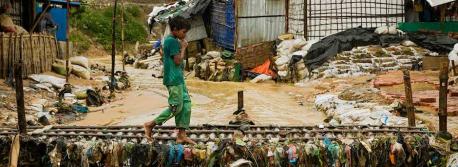
Monsoon Relief
When monsoons and other natural disasters strike, UNICEF is among the first on the ground—sometimes even days before to preposition supplies.
What is a monsoon?
A monsoon occurs when the strongest winds in a region change or reverse direction, typically seasonally or every six months. Monsoons are common where the Indian Ocean and Pacific Ocean meet, affecting mainly South and Southeast Asia. Depending on the direction of the winds and geographical location, areas can experience and alternate between wet or dry monsoon seasons. Wet monsoons tend to be linked to summer, bringing in torrential rainfall and flooding. Dry monsoons are mostly associated with winter and bring in droughts. Climate change is making these seasons more extreme and, as a result, taking more lives.
Children more vulnerable to monsoon impacts
Over 500 million children live in extremely high flood occurrence zones, and some 4 billion people live under severe water scarcity for at least one month of the year. When environmental disasters hit, it is nearly impossible to outrun danger. Children are more likely than adults to drown, starve or become dehydrated from extreme weather’s impacts.
The damage monsoons inflict on homes, schools and public infrastructure robs kids of the security they need to stay healthy, develop and grow. Flooding can disable sanitation facilities and contaminate water supplies, increasing the risk of diseases like cholera and diarrhea.
In Bangladesh alone, wet monsoon season engulfs more than 35 percent of the country. If crops are destroyed, kids are most likely to suffer from malnutrition, especially when damaged roads and bridges keep humanitarian aid from reaching the families and children who need help. Monsoons and other extreme weather events can also leave children orphaned, displaced and without a childhood.
Learn how UNICEF is helping to protect Rohingya refugees living in Bangladesh from monsoons.
By as early as 2025, half of the world’s population will be living in water-stressed areas. Without adequate water supply, sewage systems fail and there is insufficient water for basic hygiene needs. Access to safe water to maintain proper hygiene and sanitation is critical, especially amidst COVID-19.
How UNICEF helps monsoon victims
When monsoons and other natural disasters strike, UNICEF is among the first on the ground—sometimes even days before to preposition supplies. UNICEF's supply operation, which includes the largest humanitarian supply warehouse in the world, enables the delivery of lifesaving supplies to anywhere in the world within 48 to 72 hours.
Working with local partners, UNICEF provides safe drinking water, hygiene and sanitation kits, medicine, nutrition and more. UNICEF also creates Child-Friendly Spaces and temporary classrooms, safe spaces for displaced children to learn and play and receive psychosocial support. UNICEF protection teams work to reunite separated children with family members.
Once the immediate crisis has passed, UNICEF works to prepare communities for the next emergency by assessing risks and helping strengthen health care systems, schools and other community services to become more extreme-weather resilient.
Learn more about how UNICEF works to address climate change and its impact on children.